Botox for Jaw Clenching
Chronic clenching of the jaw or grinding of the teeth, a condition known as bruxism, can have a variety of problematic effects. It can cause pain and tension in the jaw to chronic headaches or migraines to earaches and facial pain to damage to your teeth. These symptoms make bruxism an ever-present, constantly painful condition. This is why Dr. Michele Green in NYC was one of the first dermatologists to treat her patients with Botox injections in the masseter muscle. Bruxism is extremely common, affecting many people across the country and around the world. Common risk factors for developing bruxism include stress, frustration, and anxiety – feelings that many of us experience daily. Treatments like mouth guards help to mitigate the symptoms of the condition – such as preventing tooth damage – rather than address the root cause. Some individuals are just told to “reduce the stress in your life” which often feels like wishful thinking. If you have tried mouth guards, muscle relaxation activities, or other treatments and nothing is working for you, you may be the perfect candidate for Botox injections for jaw clenching and teeth grinding.
When many people hear “Botox,” they automatically think of treating wrinkles and maintaining healthy, youthful skin. But, Botox can also be used to treat many conditions, including bruxism. OnobotulinumtoxinA, also known as botulinum toxin A or Botox can be used to freeze or relax muscles, which includes the masseter muscles, the jaw muscles responsible for chewing, and clenching your teeth. Botox treatment can work wonders in relieving tension along the jawline responsible for bruxism, keeping you free from pain and the fear of grinding away the enamel of your teeth.
If you are tired of constant pain, headaches, earaches, or tooth enamel damage from jaw clenching, Dr. Michele Green in NYC is here to help. Dr. Green is an expert in treating bruxism with Botox injections and relieving you of temporomandibular joint (TMJ) disorders. Whether it is teeth grinding at night, TMJ or the desire for facial slimming, Botox injections into the masseter muscle will relieve these unwanted side effects and can also provide cosmetic improvement as well. Dr. Green utilizes Botox as one of the main treatment options to relieve jaw clenching and TMJ in New York City and it is one of the most popular procedures in her discrete dermatology office.
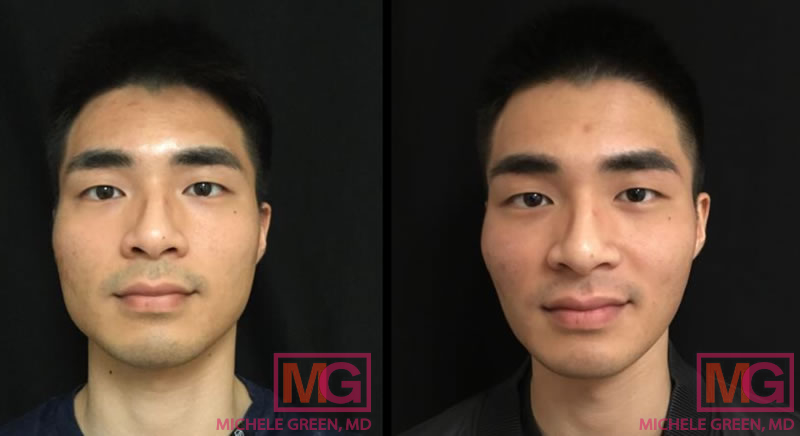
Botox for masseter muscle area, 3 months
What can Botox do for the jaw?
Botox can help alleviate the symptoms of bruxism (teeth grinding), jaw clenching, and temporomandibular joint (TMJ) disorders. These symptoms often include pain, lockjaw, damaged teeth, headaches, earaches, and discomfort. Botox can also help with facial slimming. Many individuals with bruxism or jaw clenching overuse their masseter muscles which cause them to grow in size and give the appearance of a square jawline. When Botox is injected into the masseter muscle, the muscle will become relaxed and will not contract as forcefully as it used to before. Over time, the masseter muscle will shrink in size due to disuse and will give the appearance of a slimmer face.
What is bruxism?
Bruxism is a common condition that is characterized by consistent, involuntary teeth grinding and/or jaw clenching. Bruxism can occur both during the day and at night while you are asleep. This tension along the jaw can cause a variety of symptoms including jaw pain, clicking or tightening of the jaw muscles that limits how much you can open your jaw (sometimes known as lockjaw), tension headaches and migraines, earaches, tooth or gum sensitivity, and damage to the tooth enamel. Furthermore, the constant clenching of the masseter muscles, which are the muscles that connect your cheek and your jaw and are responsible for chewing, can cause the jawline to take on a severe square shape as the muscles along your jawline grow larger. While many people suffer from chronic jaw clenching and teeth grinding, the risk of potential damage to the teeth and the pain that bruxism can cause are two very compelling reasons to seek treatment options.
What causes bruxism?
There are a lot of risk factors that can lead to bruxism, many of which are extremely common. One of the major potential causes of chronic jaw clenching and teeth grinding is stress. When you are stressed or anxious, your body reacts by tensing up and many people carry that tension in their jaw. If you find yourself frequently in situations where you are feeling frustrated or angry such that you are often gritting your teeth, you are also at risk of developing bruxism. Certain medications, such as antidepressants, can put you at risk of developing bruxism as well as consuming caffeinated drinks or alcohol. Bruxism that happens while you sleep can be the result of sleep apnea or other sleep-related disorders. It is believed by researchers that the risk of developing sleep bruxism is hereditary, meaning there is a higher likelihood of clenching your jaw or grinding your teeth when you sleep if you have a family history of those things.
How does Botox help with jaw clenching?
Injections of the botulinum toxin type A, a neurotoxin injection known more commonly as Botox treatment, are much more than just a cosmetic treatment. In addition to eliminating wrinkles and rejuvenating the face for a smoother, younger look, Botox can be used to treat other conditions – bruxism included. When botulinum toxin A is injected into the masseter muscles or temporalis muscles, which are the main muscles that contract while chewing, the neurotoxin injection works to relax the muscles. This helps to release tension in the jaw for pain relief from aches caused by chronic jaw clenching. It can also help to smooth out the square jawline that can occur from hypertrophy (overuse) of the masseter muscles. Research has shown that Botox for jaw clenching is effective, though the FDA has not yet officially approved Botox to treat bruxism. Still, this “off-label” use of Botox has been shown to safely and effectively reduce the symptoms of bruxism. Patients who receive the treatment will start to see the effects of Botox one to three days following the procedure, which will last for approximately three months. Treatment can be repeated once the effects wear off for lasting pain and damage reduction.
Does Botox help with bruxism?
Yes! Botox is an effective treatment for bruxism that works by freezing the muscles responsible for the tension along the jaw. This freezing of the masseter muscle along the jaw prevents the tension in the facial muscles that is responsible for the pain and damage caused by bruxism. The effects of Botox treatment can last up to three months but the treatment can be repeated for continued relief from aches, pain, and damage along the jaw and teeth.
What is Botox made from?
Botox is made from a neurotoxin produced by the bacterium Clostridium botulinum. Botox specifically uses botulinum toxin type A. This toxin causes paralysis as a result of blocking neural transmission. Botox is a purified manufactured form of this botulinum type A toxin and is injected in small quantities into precise locations, to freeze the muscle. When injected into the masseter muscle, the masseter muscle will release tension and become relaxed. The muscle will eventually shrink over time with disuse. Botox will help alleviate many of the symptoms that are associated with bruxism like damage to the enamel of your teeth, TMJ, lockjaw, migraines, and more.
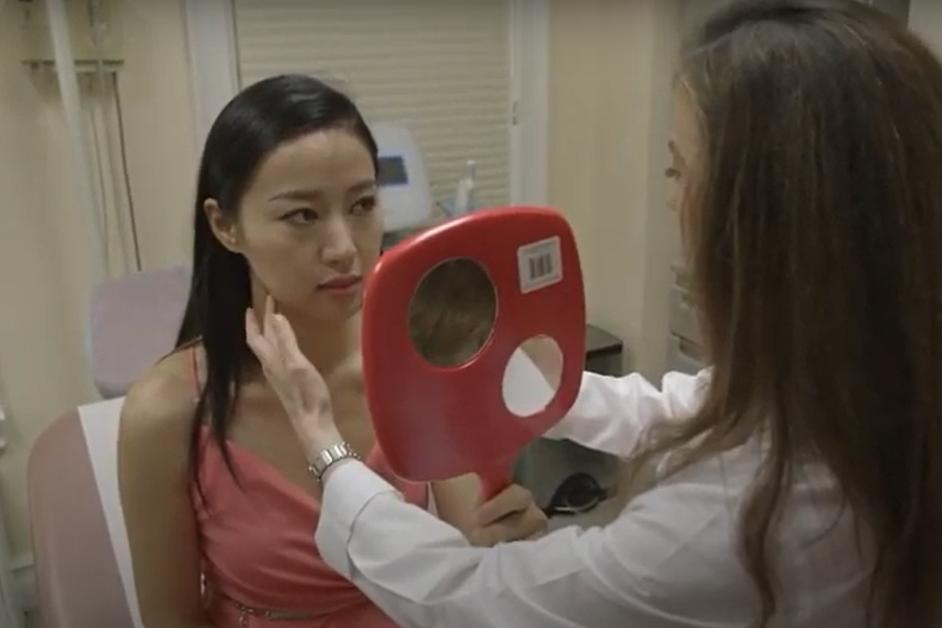
Can Botox be used for jaw clenching? Does Botox help with jaw clenching?
Yes and yes! A part of the condition of bruxism is involuntary, repeated clenching of the jaw. When Botox is injected into the masseter muscles, it causes the muscles to essentially become relaxed. The botulinum toxin blocks the neurotransmitters that are responsible for telling the muscle when to clench. As a result, the involuntary, chronic clenching of the jaw is reduced, which abates the symptoms like lockjaw, TMD, tension headaches, earaches, and weakening of the enamel.
Can Botox help with teeth grinding?
Yes! Chronic teeth grinding that occurs both during the day and night can wreak havoc on your oral health, leading to tooth damage, such as the wearing away of the enamel, and gum sensitivity. When you have bruxism that manifests as incessant and involuntary grinding of the teeth, the first treatment that is suggested is typically a mouthguard. These night guards can be effective in preventing damage but they don’t address the hypertrophy of the masseter muscles themselves. Further, if you suffer from excessive teeth grinding during the day, a mouth guard may not be the best option. If you are looking to improve your dentistry, Botox can be very effective in preventing teeth grinding, as the injection relaxes the muscles responsible for the jaw tension that leads to teeth grinding.
What is temporomandibular joint syndrome?
Temporomandibular joint syndrome, also known as TMJ syndrome, is a potential side effect of bruxism, which can lead to serious and painful disorders if not addressed. The temporomandibular joint connects your jawbone to your skull on each side of your head and acts as a hinge for you to speak and chew. Chronic jaw clenching can lead to TMJ syndrome, which is characterized by symptoms such as joint and jaw pain or tenderness, earaches or aches around your ear, trouble with chewing, lockjaw, and/or scraping and clicking when you open your jaw. Left unchecked, TMJ syndrome can lead to TMJ disorder (also known as TMD), which is when the temporomandibular joint is damaged or the disk is moved out of place. This can not only disrupt your usual ability to eat and speak but is also extremely painful. Chronic jaw clenching and/or teeth grinding is a major risk factor for developing TMJ disorders.
Can Botox injections be used as TMJ treatment?
Yes! Botox injections are used to freeze or relax the muscles and when injected into the masseter muscles of the face, the tension in the temporomandibular joint that results in TMJ disorders can be relieved. A research team from Baylor College of Medicine in Houston determined that Botox to treat bruxism can be highly effective in treating TMJ. The study showed that patients who received the Botox treatment to treat bruxism were more likely than those receiving the placebo to have reduced pain and fewer symptoms. This was particularly true for patients with TMJ dysfunction as a result of their chronic jaw clenching.
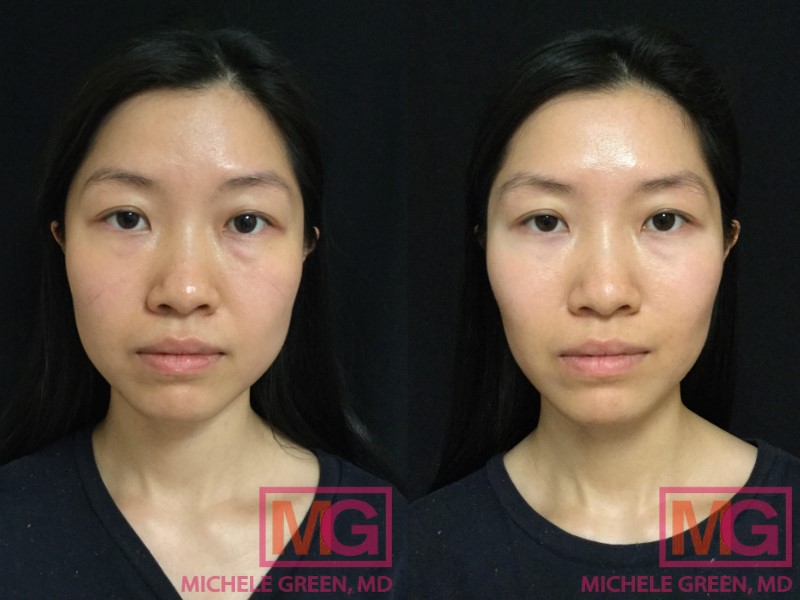
Botox for Masseter muscles – 2 weeks
What is the procedure for getting Botox to treat bruxism?
When you have decided to seek treatment for the pain, tension, and damage that bruxism can cause, you will begin with a consultation with Dr. Green. Together, you will discuss the type of pain you are experiencing and the individualized treatment plan that is right for you. In the days before your Botox treatment appointment, it is recommended that you stop taking blood thinners to reduce the risk of side effects from the procedure such as bruising and swelling.
When you arrive for your appointment, Dr. Green may begin by applying a numbing agent to the injection site to help to reduce potential discomfort. Most patients feel minimal discomfort during the procedure due to Dr. Green’s gentle and well-practiced hand. After preparing the injection site, Dr. Green will use a thin needle to inject the Botox through the cheek into the masseter or temporalis muscle. Injections will typically be made on each side of the face. When the botulinum toxin is injected, it blocks the signals that tell the muscles to contract. This then prevents jaw clenching from occurring, reducing tension, pain, soreness, and other symptoms such as damage to teeth and gums. Following the injection treatment, you can return right away to your regularly scheduled activities.
Aftercare for Botox for bruxism
Botox is a non-invasive bruxism treatment, which means that there is no recovery or downtime necessary following the procedure. You can go back to your regular activities immediately following the treatment. Further, while Botox treatment is extremely effective in relaxing the facial muscles, it does not limit any regular facial movement like chewing or making facial expressions. Dr. Green recommends that you do not massage the injection site for at least 24 hours after receiving the injection to prevent the toxin from spreading to unwanted areas of your body.
It is uncommon for any side effects to occur but some potential side effects include swelling or bruising where the injection occurred, headache, a crooked smile or drooling, and dry eyes. If you experience a crooked smile, it should even itself out after a couple of days or can be adjusted with a small amount of filler. The risk of experiencing potential side effects is greatly reduced when you seek treatment from an expert board-certified dermatologist, such as Dr. Green, who has been safely and effectively treating patients with Botox for years. Precise placement of the injections is imperative in avoiding these side effects.
You will begin to experience the results of the Botox treatment one to three days following the treatment. The effects of Botox can last for approximately three months, though the treatment can be repeated for a continuation of bruxism symptom relief. When you consult with Dr. Green, the two of you will determine the treatment schedule that works best for you.
How many units of Botox do I need for jaw clenching?
The number of units an individual will need for jaw clenching varies based on each individual. Some individuals have much stronger masseter muscles which will require more units of Botox. When you consult with Dr. Green, she will determine how many units of Botox you will require for your case. On average, patients receive 15 to 25 units of Botox on each side of the face, which will be injected simply and painlessly into their masseter muscles. Depending on the strength and hypertrophy of the muscle, more Botox may be needed. The effects of Botox for jaw clenching will typically last about three months before the treatment can be repeated.
How many units of Botox do I need for teeth grinding?
When patients ask how many units of Botox are for bruxism, specifically teeth grinding, the answer is: it depends. There is no “one size fits all” treatment when it comes to Botox injections and Dr. Green considers each case before determining the number of units needed. Typically, patients receive between 15 and 25 units on either side of the face to address teeth grinding.
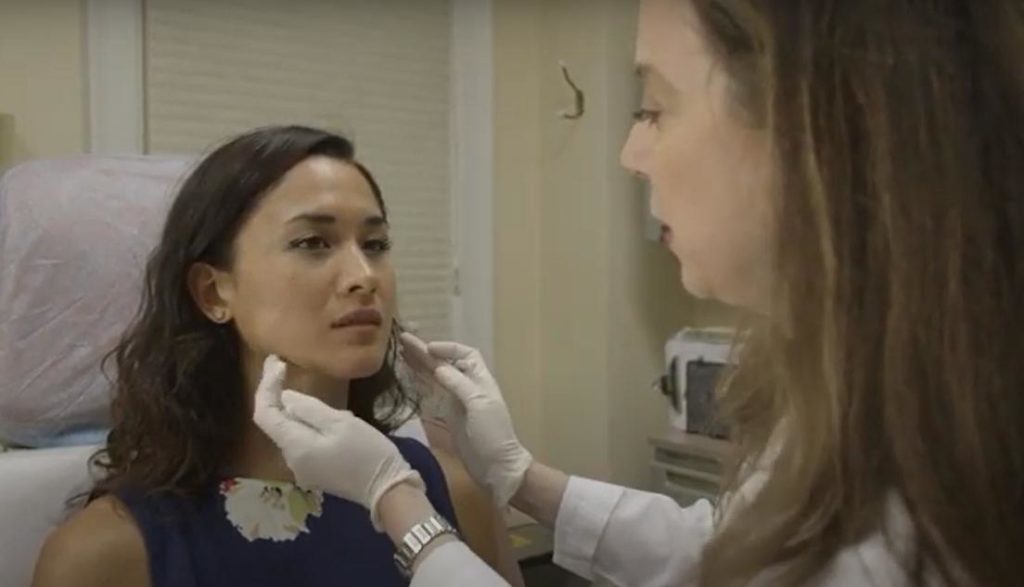
When does jaw Botox start working?
The great thing about jaw Botox is that it starts working right after your treatment. It may take one to three days to up to a week to begin to see a real difference in your jawline and relief from symptoms of TMJ disorders or bruxism. If you get jaw Botox, she will have you follow up two weeks after the procedure to see the progress of the Botox and to see if any additional Botox should be injected to give you the optimal results. Over the next few months, you should see continual improvements in the form of a slimmer jawline and alleviation from adverse symptoms. You will then need to come in for another jaw Botox treatment after three to four months for continual relief
Why does botulinum toxin work for jaw clenching?
Botox or botulinum toxin A works for jaw clenching because when injected, it freezes the muscles responsible for the tension along the jaw. Botox freezes the masseter by blocking the release of acetylcholine, a compound that is responsible for muscle contraction. The Botox will effectively reduce the contraction of the masseter muscle which will relax your jaw and prevent clenching and its associated symptoms of pain, teeth damage, a square jawline, and headaches.
What are the side effects of Botox for TMJ or jaw clenching?
Side effects from Botox for TMJ or jaw clenching are uncommon. Some of the more common potential side effects include having a headache or a temporary eyelid droop. If you experience an eyelid droop or minor asymmetry of your face, it should even itself out after a couple of days or can be adjusted with a small amount of filler. Other potential side effects include swelling or bruising where the injection occurred, minor pain, and muscle weakness. The risk of experiencing potential side effects is greatly reduced when you seek treatment from an expert board-certified dermatologist, such as Dr. Green, who has been safely and effectively injecting patients with Botox for years. Precise placement of the injections is imperative in avoiding these side effects.
What are other treatment options for bruxism?
Several treatment options can be used in addition to Botox for bruxism. Typically, many patients who experience excessive, involuntary jaw clenching and teeth grinding will start their treatment with an oral splint or mouthguard. The mouth guard is typically worn at night and can help prevent damage to the tooth enamel that results from the grinding of your teeth. While the use of oral splints is an important first step in tooth damage prevention, they are typically only worn at night and therefore not effective for those who suffer from daytime bruxism. Further, night guards do prevent the wearing away of enamel but do not prevent tension in the jaw so patients may still experience soreness, tension headaches, earaches, and tight or locked jaws.
A treatment option for patients who experience bruxism during the day is to use biofeedback. This is when you wear sensors that monitor the activity that leads to muscle tension and sends you a signal when jaw clenching is going to occur. The idea is that when you are aware of the tension that is occurring, you will be able to relax the muscles in your jaw. Biofeedback can be a great way to start your treatment but if you find that it is not enough to prevent you from clenching your jaw, Botox may be the best solution for you.
If you are experiencing jaw clenching or teeth grinding as a result of stress, anxiety, anger, or frustration, another treatment suggestion is to address the cause of your stress and/or practice muscle relaxation exercises. Often though, this is much easier said than done and patients can again turn to Botox for relief from the pain caused by bruxism.
Which Botox lasts the longest?
Currently, all forms of neurotoxins, including Botox, Dysport, and Xeomin, last up to four months in duration. The Revance company currently has a form of Botox known as Daxibotolinumtoxin A in the pipeline for FDA-approval. Daxibotulinumtoxin A is expected to last 20 to 24 weeks compared to the typical 12 to 14 week lifespan of Botox currently on the market.
Does jaw Botox slim the face? Does it help with a square jawline?
Yes! Excessive clenching of the jaw can overexert the muscles in your jaw, which is also known as hypertrophy of the masseter muscles. The masseter muscle in your jaw is similar to all muscles in your body in that the more it is engaged, the larger it will get. When this occurs as a result of bruxism, your jaw can take on an excessively square shape, which many patients find upsetting if that is not the natural contour of their face. Luckily, the Botox treatment that is used to stop the masseter muscle from clenching will not only reduce the pain and potential enamel damage done by bruxism but can correct the square jaw side effect as well. When the botulinum toxin is injected for the Botox treatment, it serves to shrink the jawline, which will create a V-shaped, slimmer-looking face.
How much is Botox for jaw clenching?
The cost of Botox for bruxism is variable depending on several factors. First of all, it is important to consider how many units of Botox you will be receiving to treat jaw clenching. This amount is dependent on each individual’s needs, which will be determined during your initial consultation. Some cosmetic dermatologists may also treat by the area rather than by unit. Additionally, the cost of Botox for jaw clenching depends on the certification and experience of the treatment provider. If you seek treatment with a nurse or at a MedSpa, treatment will be less expensive than if you go to a board-certified, expert dermatologist, like Dr. Michele Green in NYC. However, receiving treatment from a certified and very experienced dermatologist has been shown to reduce the risk of side effects following the procedure. Botox injections are a very delicate process that requires extreme precision. To get the best treatment possible, it is recommended that you seek out an expert dermatologist such as Dr. Michele Green in New York.
Does insurance cover Botox for jaw clenching?
Botox is generally not covered by health insurance for jaw clenching. Some insurance companies cover Botox injections for certain medical conditions but it can be quite complicated to get insurance to cover Botox. Botox for bruxism is currently an “off-label” use of Botox, which may affect if the procedure can be covered by insurance. The only way to determine whether Botox is covered by insurance is to confirm directly with your insurance provider.
Is Jaw Botox FDA approved?
Botox is currently not FDA-approved for the treatment of TMJ disorders. It is currently considered “off-label” use for Botox but has been used for several years to treat TMJ disorders with much success. Countless individuals have turned to Botox when other alternatives failed to alleviate the symptoms of TMJ disorders and have been extremely happy with their results. Many patients experience almost immediate relief from the pain associated with bruxism and teeth grinding. In Dr. Michele Green’s private dermatology office, Botox injections to treat TMJ disorders and facial slimming is the one of the most popular procedures that she performs.
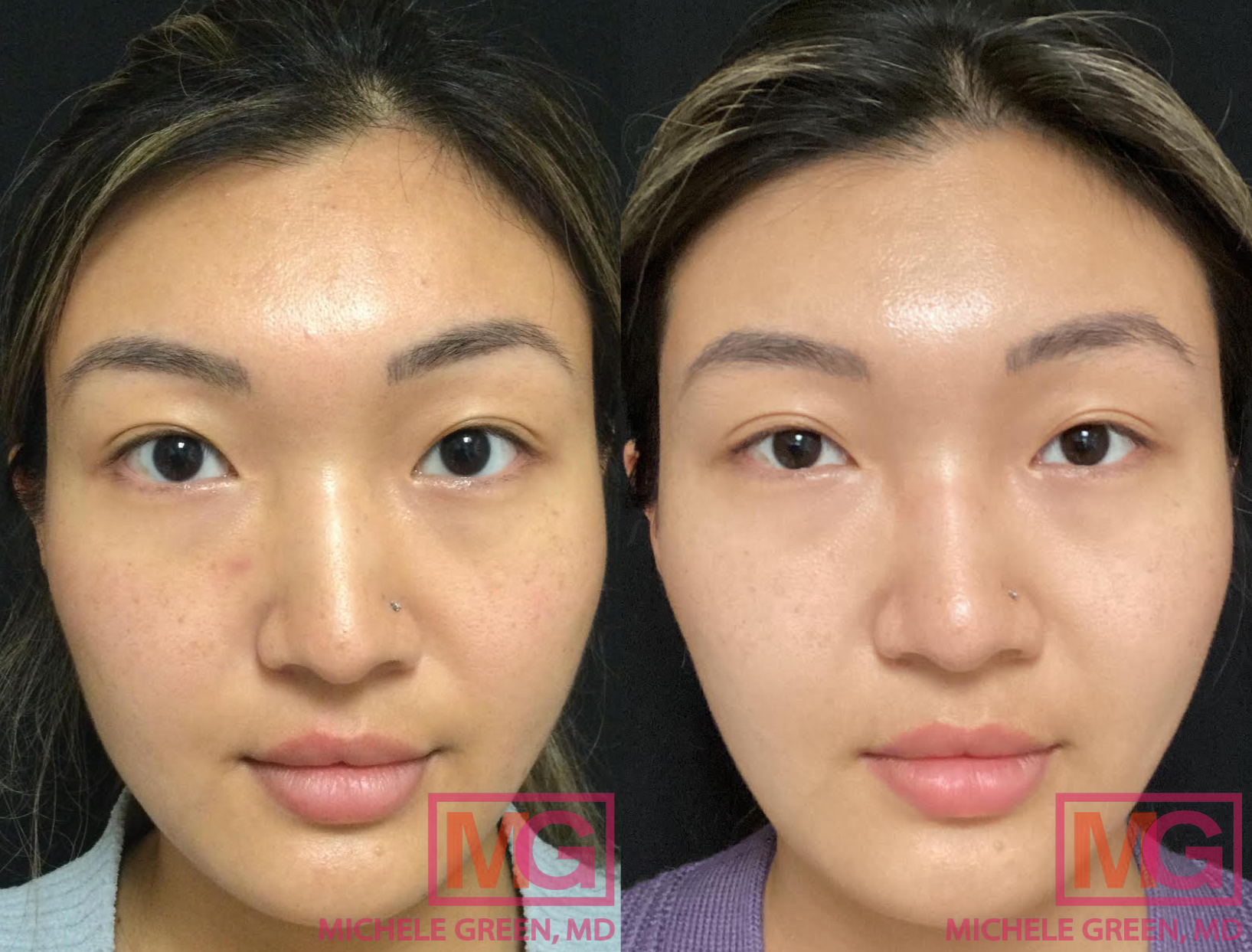
Botox in Masseter area, 6 months before and after
What are the side effects of Botox for bruxism?
Botox is a non-invasive procedure that involves injecting the botulinum toxin type A into the treatment area of the face. As such, the risk of side effects is low, especially when you are receiving treatment from a board-certified, experienced dermatologist. Potential, non-serious side effects that can occur following the procedure include: bruising or swelling at the injection site, headache, dryness or involuntary tearing in the eyes, or drooling. Any side effects that occur typically abate after several days.
Even though Botox is a non-invasive procedure, it is a treatment that still takes a lot of skill and precision to perform. Receiving the treatment at the hand of someone who is not an experienced or board-certified dermatologist increases the risk of more serious side effects, which can occur if the botulinum toxin spreads to other parts of the body. If this were to occur, you may experience weakness in the muscles throughout your body, trouble with your eyesight, trouble breathing, difficulty speaking, or the inability to control your bladder. If you do experience these side effects, be sure to call your doctor right away.
How do I get started with Botox injections for treating jaw clenching and teeth grinding?
If you suffer from chronic, involuntary jaw clenching and teeth grinding, Botox can offer significant relief. Botox injections also are a safe and effective treatment in the masseter muscle for facial slimming. Dr. Michele Green was one of the first dermatologists to treat patients with TMJ and bruxism with Botox in her discreet, private NYC office. Dr. Green is consistently voted as one of the best dermatologists in New York by Castle Connolly, the New York Times, Super Doctors, and New York Magazine, for her cosmetic injections, dermal fillers, and other non-invasive procedures. Please contact us online today or call 212-535-3088 to schedule a consultation with Dr. Green to determine if Botox injections for jaw clenching are the best treatment for you.
 212-535-3088
212-535-3088